Category: Hunting Blog
Antler Growth And The Importance Of Minerals
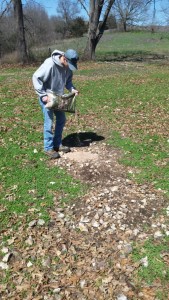
Intern, Clay O’Dell, is placing Trophy Rock’s Four65 in front of a Reconyx camera.
It doesn’t seem possible, but spring has arrived and the yearly cycle of antler growth is continuing. Not long ago it seems like we were chasing whitetails during the winter months, and now we’re discussing velvet growing. Regardless of how quickly it got here, it’s here, and we don’t want to miss this easy opportunity to help benefit our deer herd. One of the quickest and easiest ways to help improve the health of the deer is by providing easy access to minerals.
During this time of year, bucks are preparing for new antler growth while they are still recovering from this past winter. Most of our does are pregnant and will be giving birth over the next couple of months. One important substance that both bucks and does need is mineral, and you can provide this by using Trophy Rocks or their crushed version, Four65. We generally place a Trophy Rock on every 80 to 100 acres on our property ensuring that every deer has access to a mineral supply.
One of the greatest things about using Trophy Rock or Four65 this time of year is deer will be actively using the mineral making this a great place for a trail camera! We first place our Trophy Rocks in high traffic areas where deer were already active. Once we establish the site, we won’t move the rocks, making it a great location for a trail camera year after year!
We love to check our Reconyx cameras during the spring! We’re always looking for those strutting turkeys but also checking up on our deer making sure they’re healthy and happy. If you’re looking for ways to improve the health of your deer herd don’t overlook this easy step.
Daydreaming of whitetails,
Adam
Trail Cameras For Turkey Scouting
March is a great month for turkey hunters. A lot of hunters in the South are already starting their turkey season while Grant and I, who are located in the Midwest, are using this month to scout. March in the Midwest can mean large flocks of turkeys roosted in close proximity to each other. This also means they can be very vocal while on the limb, but finding where they fly down can be difficult sometimes. Using the same trail camera you use for scouting deer, and turning on the time lapse feature can help you find the fly down area and increase your success rate once season opens.
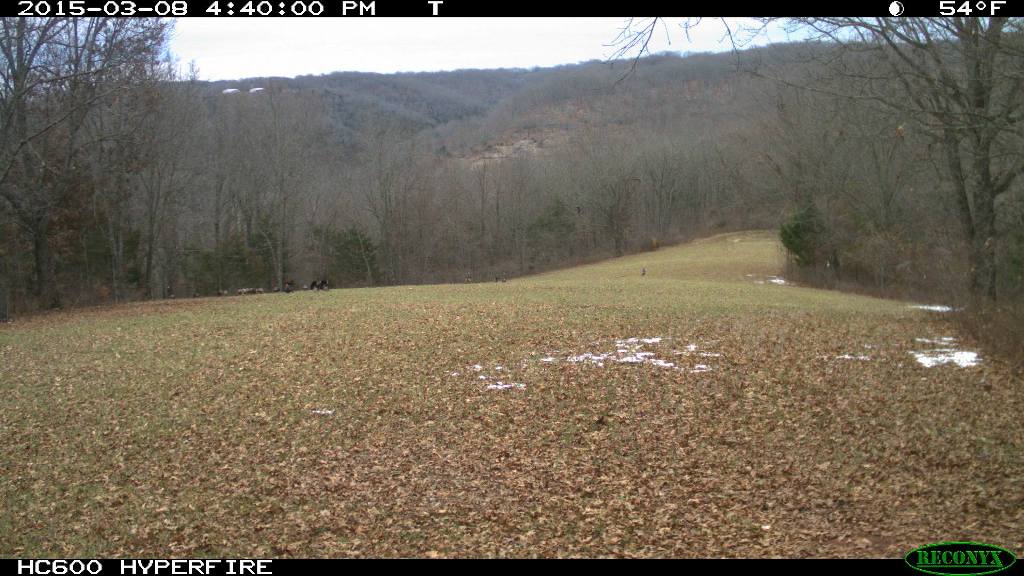
We were able to locate this large flock of turkeys using the time lapse feature on our Reconyx trail camera.
Early in the spring, gobblers are grouped up. During this time they are sorting out dominance so don’t expect them all to be roosted in the same spot a month from now, but they will most likely be close. Once you find their roost location, it’s important to try and find where they fly down and spend the early part of the morning. Although their roost site may change, the areas where they strut and feed will likely be visited throughout the spring. This could be a large field, a small opening in the woods, or a hardwood ridge. Finding this location can be pivotal to your success.
We use our Reconyx cameras and the time lapse feature to find the areas the turkeys are most active in. The time lapse feature allows us to monitor entire fields and hone in on their fly down locations. We set our cameras to take a picture every five minutes from sunrise to two or three hours after sunrise. The cameras will also take motion activated pictures or video if the turkeys are close enough to set off the motion sensor. Using trail cameras is a great way to start your spring so you can be more prepared when turkey season gets here!
Daydreaming of long spurs and long beards,
Adam
Turkey Decoys: When And Where
Using a turkey decoy has become a very popular tactic for turkey hunters. There are many variations to a turkey decoy: strutting tom, half strut tom, jake, strutting jake, alert hen, feeding hen, breeding hen, and a few others. With all of these different styles it usually brings up a set of questions, “Which ones do I use? How do I set them up?” Below are the guidelines I use every spring for my decoy setups.
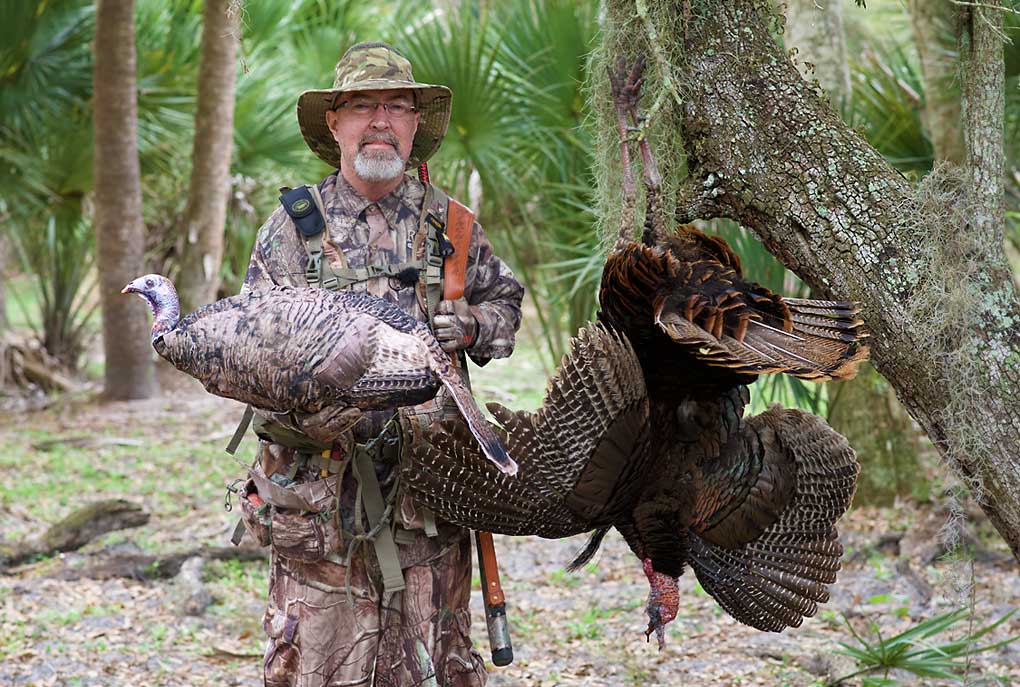
Grant was able to use the Miss Purr-fect to lure in a South Florida tom.
- Early Season or Pre Breeding – During this phase of the season dominance is the key. If the flock you’re hunting flies off the roost and walks into a field and every tom begins to strut, you’re best option is to challenge him with a strutting tom decoy with a hen decoy or two. They’re sorting out dominance this time of year and he won’t tolerate a new kid on the block, especially one with hens. As season progresses slightly, I will position the strutting decoy closer to a hen decoy, positioning the hen decoy in a breeder pose. If timed right, this approach can be deadly. This is the setup I use closer to peak breeding.
- Peak Breeding – When I see the toms and hens are starting to break off into smaller groups, I will start using a lone hen decoy. My favorite is the Montana Miss Purr-fect. Gobblers might be tired of fighting other toms during this phase. Using a lone hen will peak his interest and hopefully bring him into range.
- Post Breeding – This phase can be difficult to hunt sometimes. Hunting pressure can be high and the turkeys have sorted out dominance, finished most of their breeding, and the gobblers are focused on finding the last remaining hens to breed. The tom may have already seen the decoy spread for days and he’s not having any of it. This is where I’ll try and build his confidence and setup with multiple hens. Maybe 2 or 3 and sometimes 4, depending on the location. By using all of these hen decoys sometimes the gobbler can’t take the fact that there is that many hens and no gobbler and he’ll come in to investigate. The great thing about the Montana decoys is you can easily pack 5 hen decoys in your vest without weighting yourself down. During this phase you might need every trick in the bag to be successful.
To learn even more about decoy setup check out this cool turkey decoy setup guide at Montana Decoy.
Daydreaming of long spurs and long beards,
Adam
Hunting Feral Hogs
Growing up, late January to the middle of March was my least favorite time of year. Deer season was closed, turkey season wouldn’t open for a few months, and it was cold. For a teenage boy who loved to be outdoors, it was a boring time of year. As time has gone on, I’ve discovered new things to help get through this time of the year, and it can be almost as exciting as chasing deer in the fall!
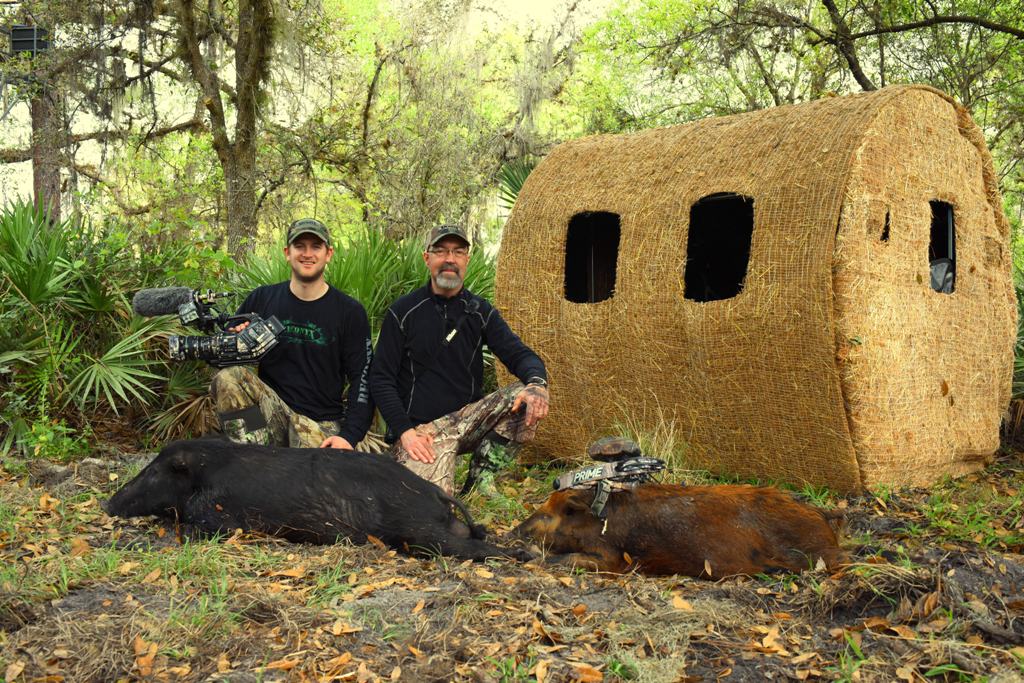
Grant and Adam enjoying a successful hog hunt in southern Florida.
Throughout America there is a growing population of feral hogs. These highly invasive animals are causing much damage. Eating crops/food plots, turning over soil, and even predating on some prey species, these reproductive maniacs are moving in on native wildlife. As wildlife managers it’s important to do our part to help balance all aspects of creation. We talk a lot about balancing buck to doe ratios and balancing predator prey relationships; it’s also important to control invasive species like feral hogs.
Hunting feral hogs is a blast! Feral hogs are very smart and have an incredible sense of smell. Hunting feral hogs will sharpen your hunting skills. Plus, they provide some excellent meat for the table. Hunting is not an effective way to decrease the population. Many landowners will need to resort to trapping, but hunting can remove several animals while you get to enjoy a great hunting experience.
Grant and I have had a lot of fun chasing feral hogs over the last couple of years, but we recently had one of our best hunts in southern Florida! Stay tuned for upcoming episodes of GrowingDeer.tv to watch it all unfold.
Daydreaming of long spurs and long beards,
Adam
Winter Preparations For Spring Turkey Hunting
The GrowingDeer Team is excited because we are blessed to begin our turkey season March 7th. Flatwood Natives has graciously invited us to kick off our season chasing birds with them in Florida. As the first hunt approaches, we are not only preparing for Florida, we are also preparing for Missouri’s opener on April 20th. No matter when your season starts, you can start preparing now.
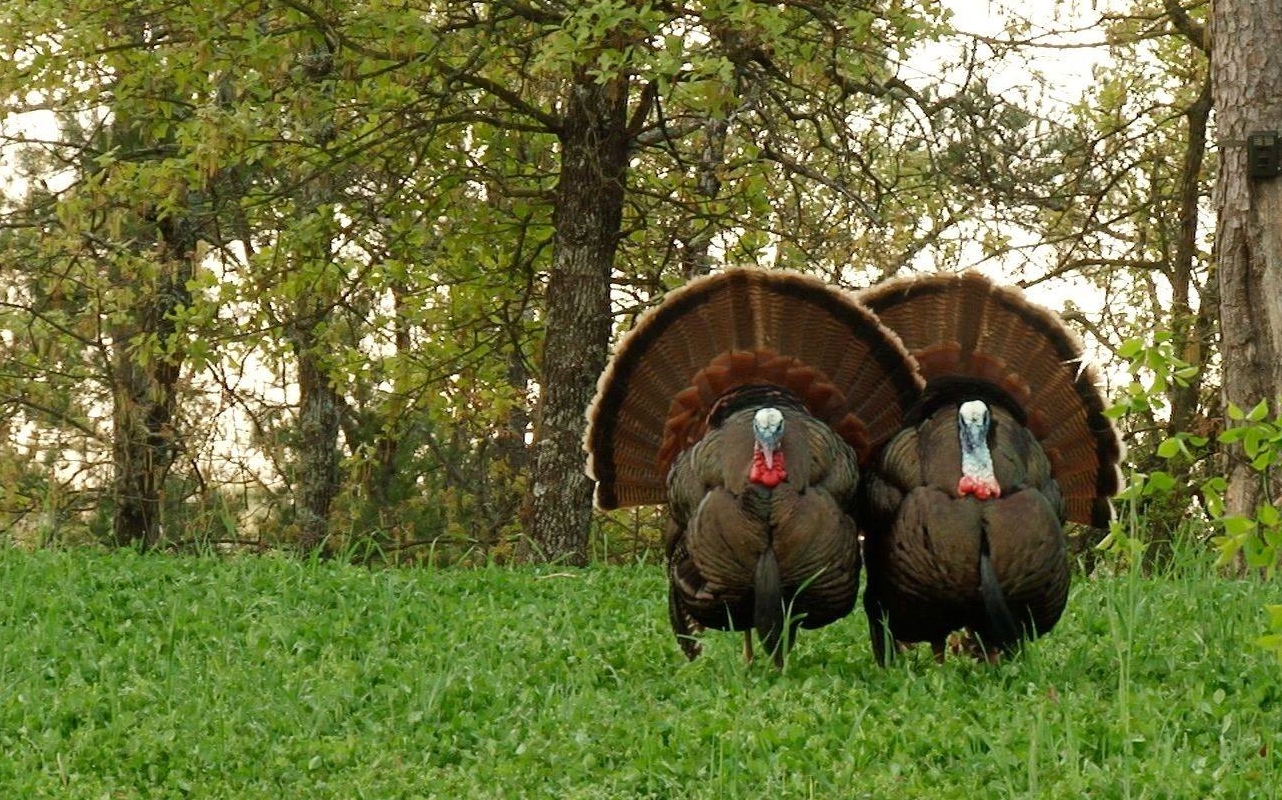
It takes the right combination of habitat, food, and calling for a great hunt.
You may have watched the recent unboxing video of Adam opening our new turkey calls from Hooks Custom Calls. We were excited to find several different diaphragm, slate, and locater calls. We have been using these cold winter days to get to know each call. By practicing our calling now and becoming familiar with our new hunting tools, we will be well prepared for turkey season. As turkey hunters/wildlife managers, we know it takes a great call AND quality habitat to get a long beard within range.
We recently burned several hardwood slopes that have established clover plots on the ridge tops above. We are excited! Burning is a known management tool for turkey, especially in the early spring, and can create great hunting opportunities.
By clearing the forest floor we have improved the property’s nesting habitat. As native forbs and grasses grow over the next few weeks, the burned area will become an ideal place for hens to lay their clutches, or eggs. Insects will also find the tender, new growth. The concentration of insects along with the ease which turkeys can now find them is a great food source. Ideal habitat, with an added source of food, close to a known strutting location can lead to great hunting later this spring.
Turkey season won’t get here soon enough! But we can use this time to improve habitat and practice our calling. If you do, you will be ready when toms leave the roost and hit the ground opening morning.
Managing whitetails with you,
Daniel Mallette
Dormant Season Prescribed Fires
February can be a very slow time of year for hunters, but not for us! There are plenty of things every wildlife manager can do during this time of year to improve the habitat at their property! One project that we’ve been practicing lately is prescribed fires!
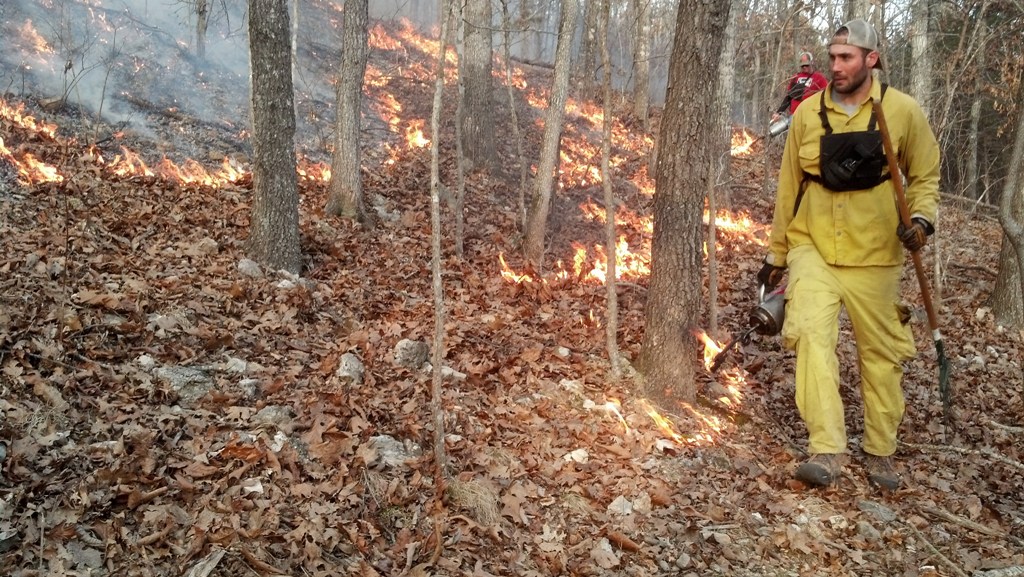
Always be careful when using prescribed fire because you can cause serious damage to trees.
There are areas on The Proving Grounds that we haven’t been able to successfully burn over the years due to slope, shade, moisture, etc. Typically these areas are on the eastern or northern slopes where during the summer the leaves on the trees shade out the forest floor and the leaves are usually still too damp to burn. During this time of year we can reach low humidity levels; when timed with dry conditions and no leaves on the trees, we can burn areas that haven’t seen fire in several years. Burning areas like these will remove most of the leaf litter and decrease the amount of ticks in this area. This happens when the tick habitat (leaf litter) is removed during the fire.
It’s a great time of year for prescribed fires on your property! Don’t let the dog days of winter get you down, get out and improve your habitat!
Daydreaming of long beards and long spurs,
Adam
Warning: This blog contains information about prescribed fire which is a management tool for trained professionals using the appropriate tools for the situation.
For The Deer Hunter You Love: Grilled, Bacon Wrapped Loin/Back Strap Recipe
Are you looking for a special meal to prepare for your special deer hunter this weekend? Show that hunter some real love with this recipe for grilled bacon wrapped loin. (Some folks would call it “back strap.”) It’s one that our family saves for those special occasions! So, take a nice, big loin from the freezer, let it thaw overnight, and create this dish your hunter is sure to love!
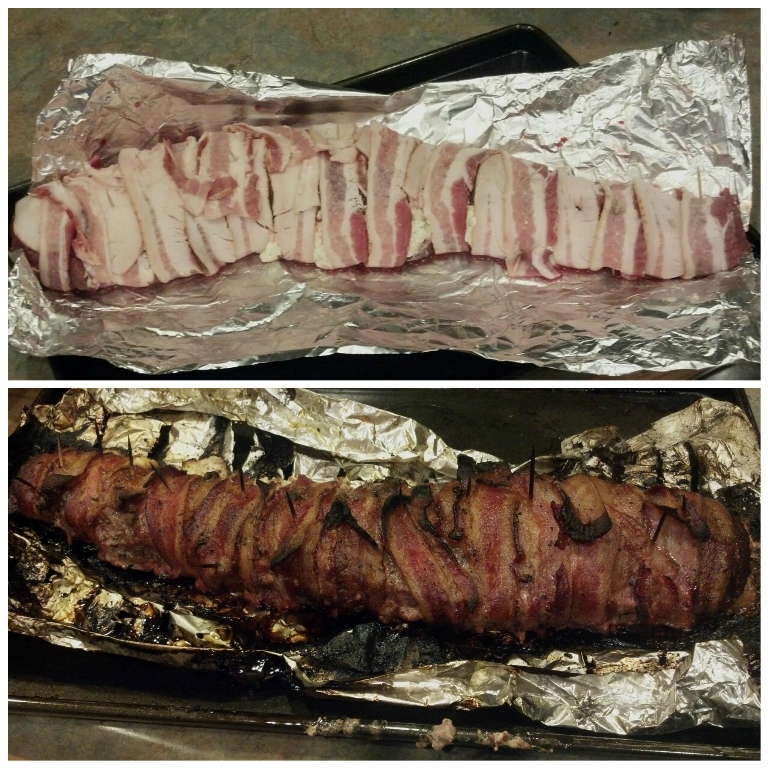
We make this amazing bacon wrapped venison loin for special occasions.
Ingredients:
- 1 large venison loin/back strap, butterflied down the middle and seasoned with pepper and garlic salt
- 1 package of bacon (approx. 2 slices of bacon per 1 ½ inches of loin)
- Tooth picks
- 8 oz. bar of cream cheese
- 4 oz. can of chopped green chilies (or if you like it spicy: 1/3 lb jalapenos cleaned, chopped and diced)
- 1 tsp. chili powder
- Heavy duty aluminum foil
Instructions:
Mix together the cream cheese, chili powder and peppers in your mixer.
Roll out aluminum foil and cut an amount that will “wrap” the loin: the length of loin long and about 12 inches wide. Put the foil on top of a baking sheet then place the loin on top of the foil.
Lay open the seasoned loin/back strap and spread/pack the cream cheese mixture down the length of the loin. Fold the loin back together, then…
Wrap 1 slice of bacon going in one direction and the 2nd piece the other (so there is no back strap showing and the cream cheese does not come out). Stick tooth picks in to hold the bacon on while grilling.
Fold the foil around the loin leaving the top open. Transfer venison package onto hot charcoal or gas outdoor grill.
Grill until all the bacon is cooked.
Some side dish ideas:
Baked potatoes – use the left over cream cheese and jalapenos on top
Corn on the cob – with pepper cream cheese as a spread
Mashed potatoes – with pepper cream cheese sauce*
*Cream Cheese Sauce: Over low heat combine pepper cream cheese (left over) and sour cream in equal amounts. Salt and pepper to taste with ½ cup cooking wine, simmer. It should be a little thick. This is also a very good sauce to use for the back strap. If the sauce is too thin use corn starch to thicken, simply follow the directions on box.
My thanks go out to Jessica and Ally Wright for sharing this recipe with me! Like usual, I’ve made some tweaks to fit my family and the way I cook. I hope you and your loved ones enjoy it as much as we do!
Cooking venison for the family,
Tracy
Are You Still Thinking About Antlers?
Antlers fascinate us don’t they? We name bucks based on their antler formation. We create stories about fights hit list bucks were in that ended with broken tines. We form connections with individual bucks as we watch their antlers grow over the years and sometimes decline. There’s just something about antlers that draws us to them.
That’s why we love this time of the year. All summer the GrowingDeer Team watched antlers grow on Reconyx cameras, once again meeting old and new deer. And now as daylight hours begin to lengthen and hormone levels drop, the bucks we’ve watched all year begin to shed their antlers.
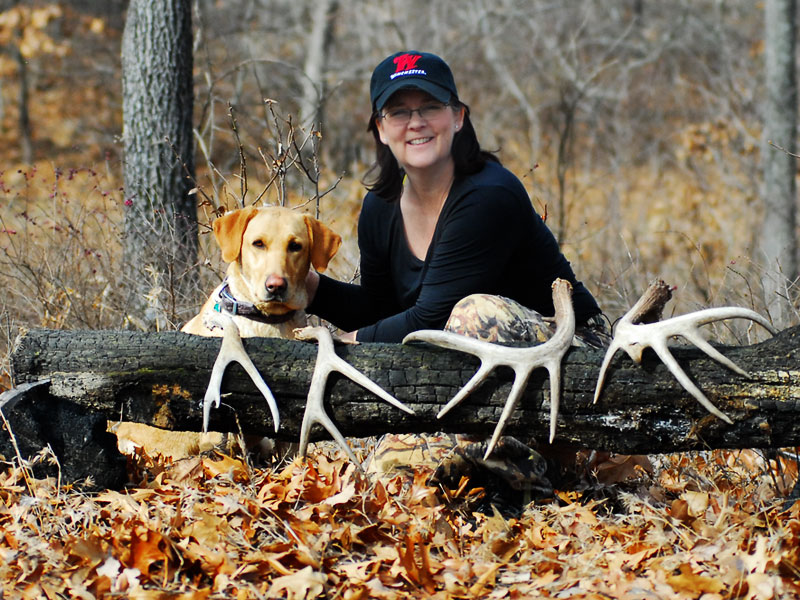
Tracy and Crystal can’t wait to start hunting sheds.
Over the next few weeks many antlers will be hitting the ground and that means shed hunting! You may have already been out looking for sheds and had great success. Others of you may not have found any yet, but don’t lose heart. If the deer in your area are healthy and have few predators, bucks may hold their antlers longer, many bucks at The Proving Grounds still have their antlers. Just be patient and keep searching.
You can bet the GrowingDeer Team will be pulling on our LaCrosse boots soon and hunting the antlers we’ve watched grow all year. For more information of where and when to look for sheds, check out episodes #123 and #116.
Managing whitetails with you,
Daniel Mallette
Scouting Early For Next Deer Season
Deer season recently closed in Missouri. Though we’re sad another season has past, part of our remedy is to begin scouting for next year. We no longer have to worry about pushing deer out of bedding areas or risk changing their patterns. Using this to our advantage, we are able to gather new information for next year.
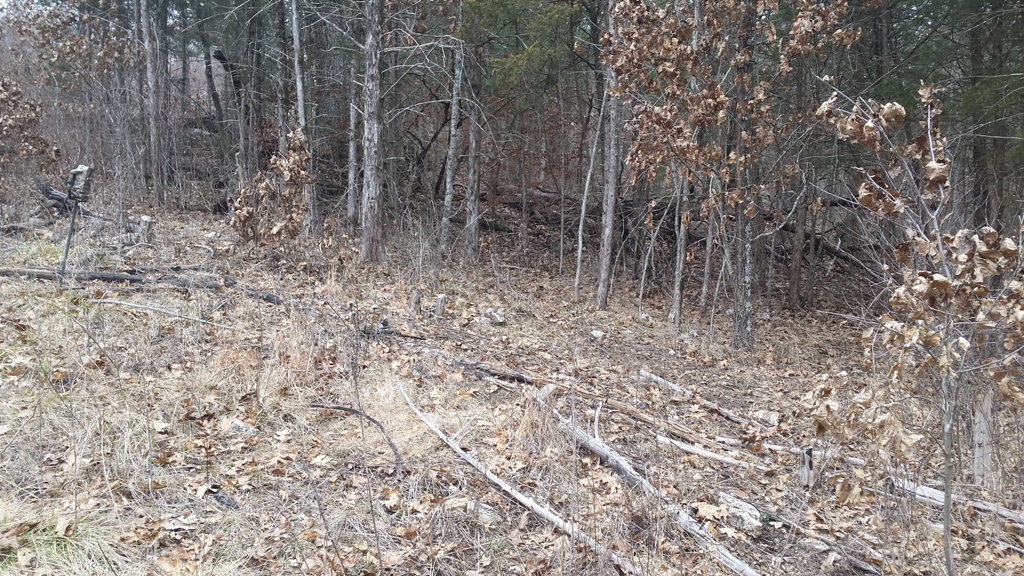
A Reconyx camera is watching a newly found trail and scrape.
When we scout, two things we look for are trails and scrapes. Trails can lead you to food, cover, and travel corridors that you may have not known existed. When looking for scrapes, look for those that show a lot of activity and are being used year after year. It may take a year or two of observation, but once you have found a great scrape, that can be an awesome hunting location. If you find a scrape make sure you watch episode 257 and 267 so you know how to properly hunt it.
Adam and I recently scouted The Proving Grounds, searching for well-used trails and scrapes. It wasn’t long before we found a trail that had a lot of sign. After a few hundred yards, it went through a mature white oak stand, an exciting food source when acorns begin to fall. Later that day we found another trail that had a great scrape. Immediately we placed a Reconyx camera on the scrape to see who was coming through. In just a few days we have gathered information that is already influencing our hunting decisions for next year.
This is a good time of the year to learn how deer are using your property. Whether you are outside shed hunting or chasing turkeys this spring, I hope you take the opportunity to begin scouting for next fall. You won’t regret it.
Managing whitetails with you,
Daniel Mallette
Balancing Nest Predators
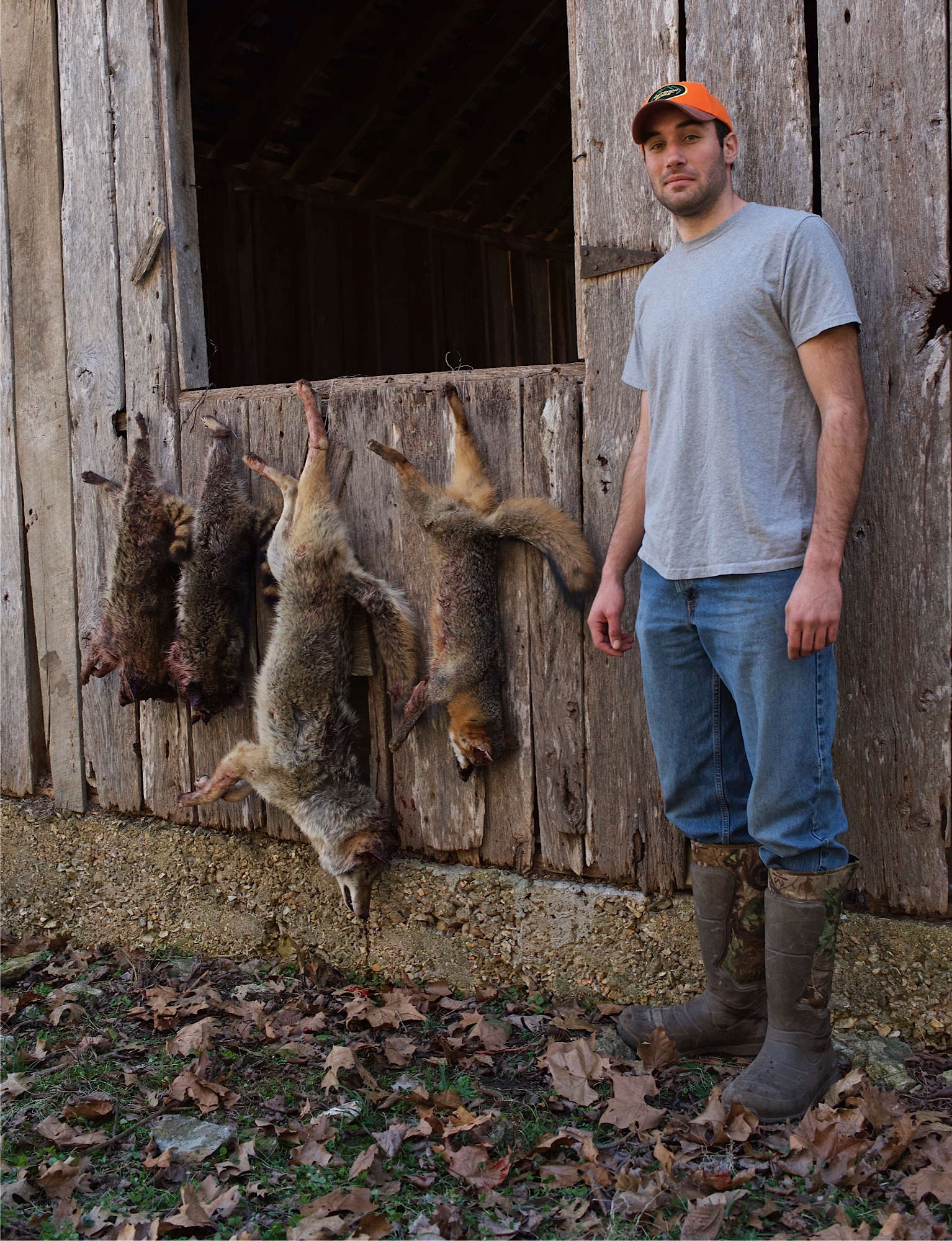
Duke cage traps caught two raccoons and Duke #4’s caught a coyote and fox.
Over the past months, early mornings have been spent in the stand, but now we get to enjoy mornings through another activity, the trap line. As I have checked traps the past few mornings, my blood has raced, hearing the year’s first turkeys begin to gobble. These moments remind me that trapping is a great management tool for turkey and other wildlife.
Last week Adam shared how Duke #4 traps are reducing our larger predators, but we are also removing many smaller predators known as nest predators. Nest predators are animals that feed on the eggs of quail, pheasant, turkey and other species. These predators can do a lot of damage very quickly. Imagine a large raccoon waddling up to a turkey nest finding several delicious eggs sitting there. It’s an easy meal that instantly removes several eggs that may have hatched. As a wildlife manager, I want to do my part to help as many eggs hatch this year, and the trap line can do just that.
We began setting out Duke cage and dog proof traps last month. These traps are easy to set and are very effective for catching smaller predators. We have already removed 32 nest predators from The Proving Grounds. Once removed these predators will be replaced by others, so we trap every year, to continuously help balance nest predator/prey populations. That means each year we have reduced the number of raccoons and opossums from eating turkey eggs that spring.
If you are interested in learning how to begin trapping, to reduce your nest predators, check out GrowingDeer.tv episodes #265 and #266. I hope you get the opportunity to do some trapping or other management projects this week. It will be worth it in the end.
Managing whitetails with you,
Daniel Mallette



